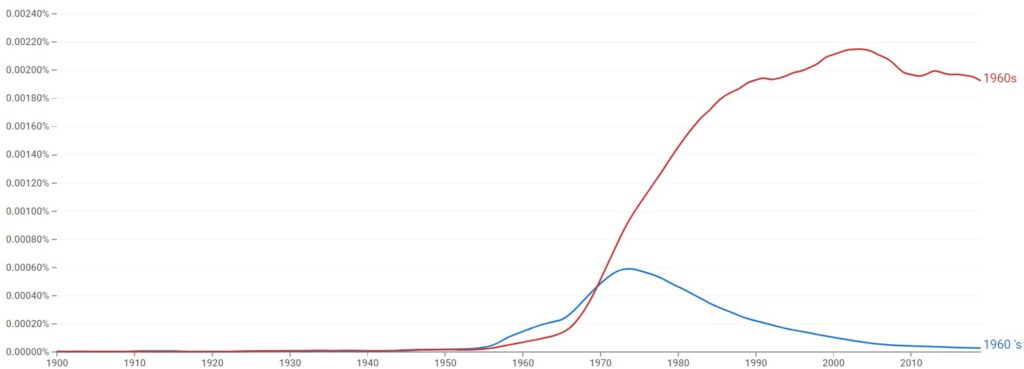You might not have put much thought into them before, but apostrophes in decades are a common talking point in English. You might want to read through this article to learn whether “1960s” or “1960’s” is correct in your writing.
Do You Use Apostrophe with Decades?
You should not use apostrophes with decades in your writing. According to most standard English style guides, apostrophes are never required to show the plural form of a decade. AP Style and The Chicago Manual of Style both demonstrate that they should be written as “1960s.”

There are no deviations to this rule in standard English. If you include an apostrophe after the decade, you are using it incorrectly.
AP Style and The Chicago Manual of Style are two of the more popular ones. They’re likely to be the styles that you’ll be more familiar with in your writing. There are others (like The Oxford Guide to Style) which also agree with the apostrophe removal.
Including the Apostrophe
You should never place an apostrophe after the decade. However, AP Style and The Chicago Manual of Style do say that an apostrophe should be included before the decade if you have removed part of the year (i.e. 1960s becomes ’60s).
The idea of placing the apostrophe before the decade shows that “19” is taken for granted. It can already be inferred from the writing that you are referring to the 1900s.
- I’m going to have to say that the ’60s were my favorite decade. I loved them so much.
- If you would like to visit the ’20s, let me know! I have a great way of getting us to relive those days.
- The ’70s live on through us, man. We’ll have to experience a true party like it’s still the 1970s!
- I want you to experience the ’80s the same way I did. I don’t think I can ever truly put it into words.
Remember, though; the apostrophe is never correct when it comes after the decade:
- Correct: If you want to visit the 1950s, I’m your guy! I’ve got the perfect cast of people to help you relive it.
- Incorrect: This isn’t the 1960’s anymore, pal. I didn’t think you were going to keep up with this charade for long.
- Correct: I want to go and see what the 1910s were like. I feel like the early ’10s are always overlooked in history.
- Incorrect: Aren’t the 1940’s supposed to be some of the most dangerous years in our history. I’m not looking forward to that.
Excluding the Apostrophe
In all cases, when you are writing out the year in full, you should exclude the apostrophe. There is never an appropriate time to write an apostrophe after the decade. Instead, you should simply follow the decade number with an “s” to show the plural form.
If you are referring to the decades as a general group of ten years, only an “s” is needed. An apostrophe is not required because there is already a clear difference between the year and the letter “s.”
- I want you to whisk me away to the 1960s. I’m sure we would have so much fun if we got to experience them.
- The 1950s aren’t all they’re cracked up to be! You know there’s a lot they had to recover from after the war.
- Did you say you were from the 1920s? I feel like that’s impossible, but I’m open-minded enough to let you humor me.
- I want to visit the 1900s. I feel like there are so many things that haven’t been discussed from back in that decade!
- Aren’t we all a little hippy? I wish the 1970s didn’t die out so quickly. I would have loved to experience the culture.
- I thought she was going to be born in the 1990s, but apparently, our new queen wasn’t meant to be!
Which Is Used the Most?
According to Google Ngram Viewer, “1960s” is by far the most popular choice, showing that it follows all the correct English rules. You will almost never see an apostrophe used in this context, which is why “1960’s” ranks so lowly on the graph.

The only time you might see an apostrophe used is when someone has forgotten or disregarded the rules associated with them. There are no exceptions, so the apostrophe is only ever included as an error or typo.

Martin holds a Master’s degree in Finance and International Business. He has six years of experience in professional communication with clients, executives, and colleagues. Furthermore, he has teaching experience from Aarhus University. Martin has been featured as an expert in communication and teaching on Forbes and Shopify. Read more about Martin here.
